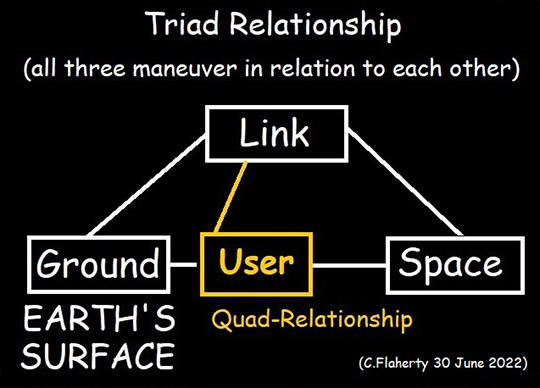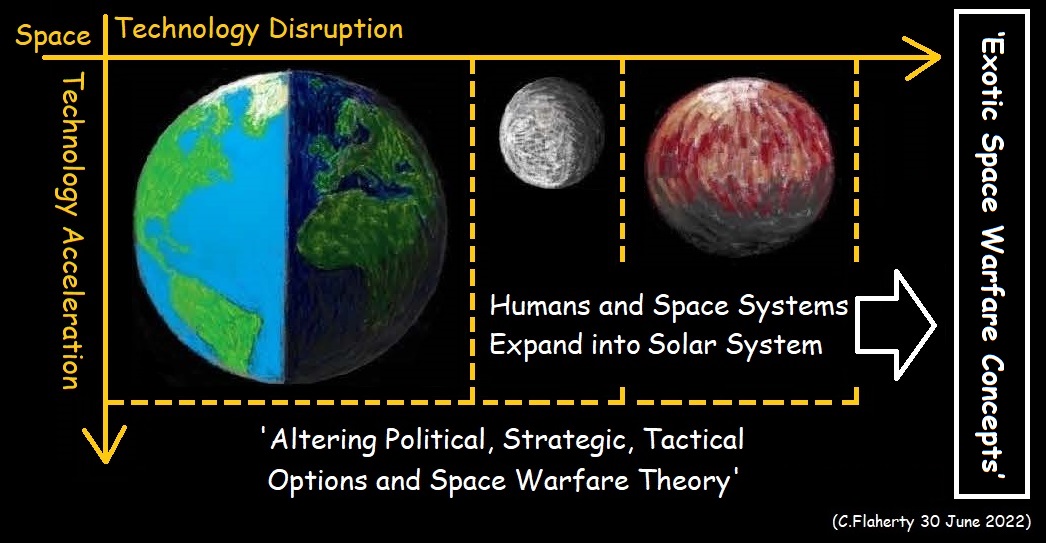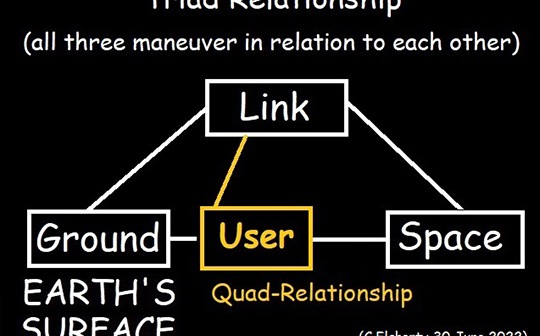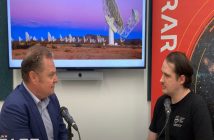
Written by Dr Chris Flaherty.
INTRODUCTION
This review looks at Space Power Concepts contained in the 2022 Australian Defence Space Command’s Space Power eManual.
Space Power Concepts looked at, are: (1) Quad-Relationship; (2) Complexity Inversion; (3) Tertiary and Mid-Level Space Power Comparison; (4) Space: The Ultimate High Ground; (5) Satellite-Spacecraft Guardians; and, (6) Third-Party Earth Survey Satellites.
(1) THE QUAD-RELATIONSHIP: SPACE, USER, GROUND AND LINK SEGMENTS
► A comparison between the USSF’s Triad of Terrestrial, Link, or Space Segments, and the Space Power eManual’s Quad-Relationships consisting of Space, User, Ground and Link Segments.
The USSF 2019 Space Capstone Publications’ Spacepower Doctrine for Space Forces, identifies three segments: Terrestrial, Link, or Space. The USSF’s Terrestrial, Link and Space Segments triad is a foundational concept in Space Power. As a core Space Power Concept, the three Segments continuously manoeuvre in relation to each other.
In regards to the Terrestrial Segment two manoeuvre states can be identified. The first manoeuvre state is that the planet Earth (the same principle applies to the Moon, or Mars) spins on its axis. A Terrestrial location moves in the rotation direction: prograde (West to East), which has significance in terms of when/where a particular set of satellites comes into view; or when a rocket is launched from the Earth’s surface, in order to get its second and third stages, into optimal position for its payload orbit. The second manoeuvre state is that an asset on the Earth’s surface can also manoeuvre (unless it is fixed to a location).
Manoeuvre in regards to the Link Segment can be a function of transferring a Ground to Satellite connection, from one station to another. This can be done, to compensate for planetary rotation, or a station is no longer functioning. The same concept also applies where the link connection is moved from one Space object to another, such as in a constellation, or that Space Communications have been inverted from the Ground, into Space – and the system is Space-Based (this is called Complexity Inversion: and is discussed later).
Space Segment manoeuvre can be a function of Circumplanetary Orbit which occurs at greater number of revolutions around the planet, or a Satellite-Spacecraft (defined later in this paper) can manoeuvre between orbits. The concept also applies to a scenario where a Satellite-Spacecraft transfers its orbit to another planetary body.
The Defence Space Command’s Space Power eManual introduces a variation on the USSF’s Terrestrial, Link and Space Segments triad, with a different definition based on a Quad-set of relationships, as its, “Space System Segments” that consist of Space, User, Ground and Link Segments. The User and Ground Segments are further defined:
USER SEGMENT capabilities can be hand-held, or mounted in vehicles, on maritime vessels and in aircraft.
GROUND SEGMENT is differentiated from the User Segment, as the Ground Segment is the Ground-Based Infrastructure and associated services.
The Space Power eManual’s definition of the “Space System Segments” consisting of Space, User, Ground and Link Segments, has taken the Terrestrial Segment (in the USSF definition), and functionally split it into two new components: User and Ground. The reason for the split reflects a different concept of Space Power: one that is fundamentally achieved from capabilities based on the Earth’s surface (as opposed to capabilities that are located in Space: orbiting the planet). The Space Power eManual identifies as a primary focus, that Space, and Space Systems, are important as an: “essential enabler of military Terrestrial operations”.
As an addendum, it should be noted that Space Power eManual recognized Space, and Space Systems as, “an operating domain in its own right.” The military-strategic way in which the Space Operating Domain is viewed fundamentally depends on two subsidiary issues: what is the level of Complexity Inversion taking place in regard to Space technology used by a Space Force; and, whether that Space Force is at a Tertiary or Mid-level state of development?
(2) COMPLEXITY INVERSION
Space Power is a product of Complexity Inversion, where the complex part of a system (and its bulk), is transferred from the Terrestrial Surface to Space. For example, historically, Satellites began as simple orbiting devices, and the bulk of the complex technology to make these function was located on the Earth’s surface. Complexity Inversion is where all the complex technology is packed into a Satellite, which operates more like a Spacecraft; which has led to a new class of uncrewed craft emerging that are part Satellite, and part Spacecraft. Satellite-Spacecraft have three qualities: (a) propulsion units; (b) fuel capacity enabling extensive, long-duration Orbital Manoeuvres, over a prolonged period of time; and, (c) have the ability to be refuelled and provided with regular maintenance in orbit. It is also expected that as technology accelerates, and disrupts, Satellite-Spacecraft will become more robotic in nature, and have Artificial Intelligence; and greater autonomy from their Human controllers.
The tertiary stage in Complexity Inversion is that a Space Force of Satellite-Spacecraft can be controlled and operated from the Terrestrial surface, or from other Space-Based Platforms. At a certain point advanced Complexity Inversion leaves little if any capability on the Earth’s surface, as all of it is in orbit around the planet. At a tertiary-level of development, Space Power becomes more about the Space Segment, and less regard is placed on Terrestrial and Link Segments.
(3) TERTIARY AND MID-LEVEL SPACE POWER COMPARISON
A Tertiary Space Power is an entity that has fully undergone Complexity Inversion into Space, operating a fleet of Satellite-Spacecraft, and where its entire infrastructure is Space-Based. That notion is reversed in the case of a Mid-Level Space Power, which operates as a Terrestrial-Based Entity, which is Space Dependent, and:
“For the military, access to Space Systems and Services is critical to enabling military capabilities and activities. The Space Domain provides, amongst other key Services: positioning, navigation and timing; force protection; intelligence gathering and targeting ability; over-the-horizon and long-range communications and command and control.” (Space Power eManual)
It can be argued that the Space Power eManual presents a ground-up view of Space Power. Greater emphasis on Terrestrial-Based activity in relation to achieving Space Control (which will be discussed in the next section on Space: the Ultimate High Ground), explains why the Terrestrial Segment was split into Ground and User Segments (rather than the triad in the USSF definition). This is because, a Mid-Level Space Power’s centre of gravity is Terrestrial in relation to its Space-Based activities. As can be seen from the Space Power eManual’s definitions, the bulk of its complexity sits on the Earth’s surface invested in various vehicles and craft that individually Link (as Users) to its Space Systems; that are all non-fixed and independently manoeuvring over the Earth’s surface. Whereas the Ground Segment represents investment in complex infrastructure required for control of its Space System. A Tertiary Space Force, is different, as it has technologically evolved to the point where it can dispense with the majority, if not all, of its Terrestrial footprint. One of the key outcomes is that Tertiary and Mid-Level Space Powers have a different conception of Space: the Ultimate High Ground.
(4) SPACE: THE ULTIMATE HIGH GROUND
A notion such as the Ultimate High Ground (found traditionally in USSF thinking from the late 1950s), grew out of a notional craft being able to achieve Circumplanetary Orbit and bomb any target within a fractional time-space unhindered. From the perspective of a Mid-Level Space Power, in the 2020s, the Space High Ground, is: “advantages offered by the vertical dimension” (Space Power eManual). That is from the perspective of Ground and User Segments, having access to a, “platform’s Orbital Altitude, or Reach”, which translates into: “the distance over which a military capability or system can contribute to desired effects.” (Space Power eManual)
Protecting Space Systems, and ensuring access to these for a Mid-Level Space Power is through various Space Control Concepts, such as Space Systems and Services hardening, and Terrestrial-Based (as legally weapons in Space are not allowed):
“Offensive and Defensive Operations to ensure freedom of action in Space by defeating efforts to interfere with or attack Australian or Allied Space Systems and, when directed, deny Space Services to a competitor.” (Space Power eManual)
However, Offensive and Defensive Space Control are only two options that exist. Other Space Control Concepts that can be considered are:
Space Resistance: A Satellite-Spacecraft, or Space System Infrastructure is sufficiently hardened to withstand an attack.
Space Dependency: Few if any nations have had (historically) complete autonomy in Space, and have been reliant (Dependent) on other countries for support of their Space Operations, and even other national territory to conduct Space related activities. Countries are ultimately Dependent on the International System to create a set of norms and behaviours regime to support their Space Operations.
(5) SATELLITE-SPACECRAFT GUARDIANS
Even though, it is the case that: “Space is a global commons and therefore not subject to national appropriation by claim of sovereignty.” (Space Power eManual) A progressive technological shift is occurring with the development of Space Force fleets of Satellite-Spacecraft Guardians: a secondary craft, which is armoured and armed; and is designed to specifically protect a Critical Infrastructure Satellite. This has led to an emerging concept of Collision Space Integrity, an area surrounding a Satellite in its orbital slot, which is monitored for any potentially threatening fly-by, by another Space object.
(6) THIRD-PARTY EARTH SURVEY SATELLITES
The current Russo-Ukraine war has shown Third-Party Earth Survey Satellites have played a fundamental role in open-sourcing every aspect of the conflict. Because of the, “concept of legal overflight unhindered by political boundaries (Space Power eManual)”, little in the way of Satellite shutter control (stopping a picture of the Earth’s surface from being taken) has been exercised by any of the combatants, or internationally. The reverse has been the case, where making public Russian troop build-ups and actions in occupied territories has been actively encouraged and published for public consumption internationally. It is expected that Third-Party Earth Survey Satellites will continue to proliferate into thousands of craft orbiting the planet, and technology acceleration will continue to develop more fine-grained surveillance, which will disrupt many of the military concepts about operational security into the future.
CONCLUSION
Reviewing Space Power Concepts in the Space Power eManual serves as a useful testbed for new concept development, as Space technology is driven along two axis: Acceleration and Disruption that fundamentally alter political, strategic, and tactical options; and the basic theory of Space Warfare. This process is illustrated in the following diagram. Humans, and Space Systems expansion into the Solar System, will hyper-accelerate the process of Space Force Complexity Inversion (as it lifts from the Earth’s Surface), operating exclusively in Space, on other worlds, or in artificial environments such as Space Stations and Habitats. The shift into exotic Space and alien environments will lead to creating new ‘Exotic Space Warfare Concepts’.






